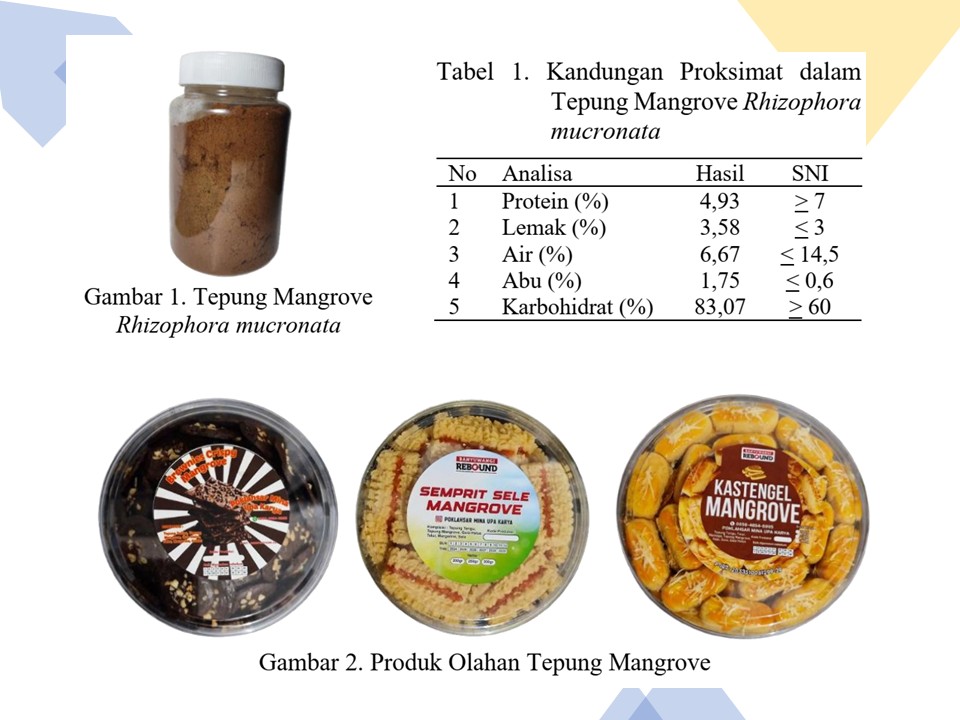Analysis of Rhizophora mucronata mangrove fruit application in enhancing mangrove tourism within the Mandar Village Community, Banyuwangi Regency
DOI:
https://doi.org/10.46252/jsai-fpik-unipa.2025.Vol.9.No.2.518Keywords:
mangrove fruit, proximate, processed mangroves, profitAbstract
The use of mangrove fruit to create economic benefit for the community is anticipated to bolster conservation efforts for the mangrove environment. In Mandar Banyuwangi Village, one application of mangrove fruit is its conversion into flour. This study aimed to examine the proximate composition of Rhizophora mucronata mangrove flour and evaluate the profitability of processing this flour into pastries. The analysis conducted encompasses the proximate content test (including protein, fat, water, ash, and carbs) and a profit analysis that factors in the cost of goods sold (COGS). Mangrove flour manufactured by Poklahsar “Mina UPA Karya” is derived from the fruit of Rhizophora mucronata. The processing method necessitated seven days to manufacture mangrove flour. The proximate composition of mangrove flour, as per SNI criteria, includes water and carbohydrate content, although protein, fat, and ash content are marginally over or below SNI specifications. Mangrove flour is utilized in a variety of desserts, including nastar, kastengel, cookies, almond chocolate, roses, jam sumprit, chocolate sumprit, peanut cake, and krispi brownies. Products made using processed mangrove flour in pastries yield a profit margin of 9.16% of the cost of goods sold (COGS). The R/C, BEPs, BEPq, profit, and profitability ratio of the mangrove flour processing business indicate profitability, since they go over the minimum requirements of profitability criteria.
Downloads
References
Ardiansyah, P. R., Wonggo, D., Dotulong, V., Damongilala, L. J., Harikedua, S. D., Mentang, F., & Sanger, G. (2020). Proksimat pada Tepung Buah Mangrove Sonneratia alba. Media Teknologi Hasil Perikanan, 8(3), 82–87. https://doi.org/10.35800/mthp.8.3.2020.27526
Bodor, K., Szilágyi, J., Salamon, B., Szakács, O., & Bodor, Z. (2024). Physical–chemical analysis of different types of flours available in the Romanian market. Scientific Reports, 14(January), 881. https://doi.org/10.1038/s41598-023-49535-x
BSN. (2009). Tepung Terigu sebagai Bahan Makanan, SNI 01-3751-2009. Badan Standarisasi Nasional.
Ernawati, Utami, C. R., Nuswardhani, S. K., Adam, M. A., & Widiastuti, I. M. (2021). Pengaruh Penambahan Tepung Buah Mangrove Tinjang ( Rhizophora Sp ) Sebagai Sumber Antioksidan Pada Pembuatan Es Krim. Jurnal TECHNO-FISH, V(2), 106–117.
Erni, N., Kadirman, K., & Fadilah, R. (2018). Pengaruh Suhu dan Lama Pengeringan Terhadap Sifat Kimia Danorganoleptik Tepung Umbi Talas (Colocasia esculenta). Jurnal Pendidikan Teknologi Pertanian, 4(1), 95–105. https://doi.org/10.26858/jptp.v1i1.6223
Fadilah, R., Sari, R., & Sukainah, A. (2020). Pengaruh Substitusi Tepung Buah Mangrove Jenis Lindur (Bruguiera gymnorrhiza) terhadap Kualitas Mie Basah. Jurnal Pendidikan Teknologi Pertanian, 6(1), 74–88. https://doi.org/10.26858/jptp.v6i1.10544
Fattah, M., Purwanti, P., Prasojo, F. I., Sofiati, D., Anandya, A., & Aisyah, D. (2023). Revenue Cost Analysis Pada Usaha Pembenihan Ikan Lele Sangkuriang Sebagai Evaluasi Profit Dt. Farm Group Jawa Barat. Agriuma, 5(2), 62–73. https://doi.org/10.31289/agri.v5i2.9305
Fattah, M., Tjahjono, A., Ghuffron, S. M., Sofiati, D., Aisyah, D., & Anandya, A. (2023). Revenue Cost Analysis Dalam Mengukur Profit Usaha Budidaya Ikan Lele Mutiara Sistem Bioflok PT ABAI Kota Malang. Jurnal Lemuru, 5(2), 201–212.
Fattah, M., Utami, T. N., & Sofiati, D. (2019). Kelayakan Finansial Dan Sensitifitas Usaha Pembesaran Ikan Gurame (Osphronemus gouramy) Di Desa Susuhbango, Kabupaten Kediri. ECSOFiM: Journal of Economic and Social of Fisheries and Marine, 06(02), 202–208.
Fitri, A. S., & Fitriana, Y. A. N. (2020). Analisis Senyawa Kimia pada Karbohidrat. Sainteks, 17(1), 45–52. https://doi.org/10.30595/sainteks.v17i1.8536
Intyas, C. A., Agus, T., & Fattah, M. (2019). Financial Feasibility Analysis Of Small-Scale Fish Smoking By Fisherman In Home Industries. Russian Journal of Agricultural and Socio-Economic Sciences, 12(December), 175–181. https://doi.org/10.18551/rjoas.2019-12.22
Jihadi, M. H. S., Badriansyah, Rostiana, S., Shofia Fatma Utami, Sofiani, I. D., & Syukur, A. (2023). Pemanfaatan Buah Mangrove Menjadi Kopi Mangrove di Bale Mangrove Potonbako Kecamatan Jerowaru Kabupaten Lombok Timur. Jurnal Pengabdian Magister Pendidikan IPA, 6(1), 150–153. https://jppipa.unram.ac.id/index.php/jpmpi/article/view/3243
Massie, T., Pandey, E. V., Lohoo, H. J., Mentang, F., Mewengkang, H., Onibala, H., & Sanger, G. (2020). Substitusi Tepung Buah Mangrove Bruguiera gymnorrhiza Pada Camilan Stick. Media Teknologi Hasil Perikanan, 8(3), 93–99. https://doi.org/10.35800/mthp.8.3.2020.29434
Nusaibah, Putri, C. M., Pangestika, W., & Luthfiyana, N. (2022). Utilization of Mangrove Fruit Rhizophora sp. and Sonneratia sp. as Raw Material for Analog Coffee. Jurnal Pengolahan Hasil Perikanan Indonesia, 25(2), 185–201. https://doi.org/10.17844/jphpi.v25i2.39852
Purwaningsih, S., Salamah, E., Sukarno, A. Y. P., & Deskawati, E. (2013). Aktivitas Antioksidan dari Buah Mangrove (Rhizophora mucronata Lamk.) pada Suhu yang Berbeda. Jurnal Pengolahan Hasil Perikanan Indonesia, 16(3), 199–206.
Rosulva, I., Hariyadi, P., Budijanto, S., & Boing Sitanggang, A. (2021). Potensi Buah Mangrove Sebagai Sumber Pangan Alternatif Potential of Mangrove Fruit As an Alternative Food Source. Jurnal Teknologi Hasil Pertanian, 14(2), 131–150.
Sakhare, S. D., & Inamdar, A. A. (2014). The Cumulative Ash Curve: a Best Tool to Evaluate Complete Mill Performance. J Food Sci Technol, 51(April), 795–799.
Sawitri, K. N., Sumaryada, T., & Ambarsari, L. (2014). Analisa Pasangan Jembatan Garam Residu Glu15-Lys4 Pada Kestabilan Termal Protein 1Gb1. Jurnal Biofisika, 10(1), 68–74. www.rscb.org
Soenardjo, N., & Supriyantini, E. (2017). Analisis Kadar Tanin Dalam Buah Mangrove Avicennia marina Dengan Perebusan Dan Lama Perendaman Air Yang Berbeda. Jurnal Kelautan Tropis, 20(2), 90–95. https://doi.org/10.14710/jkt.v20i2.1701
Susadiana, Fattah, M., Purwanti, P., Sofiati, D., Anandya, A., & Aisyah, D. (2023). Evaluasi Profit dan Kelayakan Finansial Budidaya Pembesaran Ikan Lele Menggunakan Pakan Pelet pada Pokdakan Mina Tanjung Makmur Kabupaten Tulungagung. Jurnal Sumberdaya Akuatik Indopasifik, 7(2), 135–142.
Winarno. (2008). Kimia Pangan dan Gizi (Edisi Terbaru). Mbrio Press– Biotekind.
Zielinska, E. (2022). Evaluating the Functional Characteristics of Certain Insect Flours (Non-Defatted/Defatted Flour) and Their Protein Preparations. Molecules, 27(September), 6339.

Downloads
Published
How to Cite
Issue
Section
License
Copyright (c) 2025 Mochammad Fattah, Luchman Hakim, Soemarno Soemarno, Pudji Purwanti

This work is licensed under a Creative Commons Attribution-ShareAlike 4.0 International License.


















